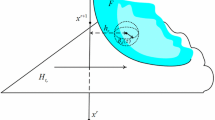Abstract
A study was made of the global minimization of a general quasiconcave function on a convex polyhedron. This nonconvex problem arises in economies of scale environments and in alternative formulations of other well-known problems, as in the case of bilinear programming.
Although not very important in our final results, a local minimum can be easily obtained. However, a major aspect is the existence of two families of lower bounds on the optimal functional value: one is provided by non-linear programming duality, the other is derived from a lexicographic ordering of basic solutions which allows the use of relaxation concepts. These results were exploited in a finite algorithm for obtaining the global minimum whose initial implementation has had encouraging performance.
Similar content being viewed by others
References
S.G. Bali, “Minimization of a concave function on a bounded convex polyhedron”, Dissertation, Engineering Systems Department, University of California, Los Angeles (1973).
M.L. Balinski, “An algorithm for finding all vertices of convex polyhedral sets”,SIAM Journal 9 (1961) 72–89.
C.A. Burdet, “Generating all the faces of a polyhedron”,SIAM Journal of Applied Mathematics 26 (1974) 479–489.
A.V. Cabot, “Variations on a cutting plane method for solving concave minimization problems with linear constraints”,Naval Logistics Research Quarterly 21 (1974) 265–274.
A.V. Cabot and R.L. Francis, “Solving certain nonconvex quadratic minimization problems by ranking the extreme points”,Operations Research 18 (1970) 82–86.
R. Carvajal-Moreno, “Minimization of concave functions subject to linear constraints”, Report ORC 72-3, Operations Research Center, University of California, Berkeley (1972).
N.V. Chernikova, “Algorithm for finding general formula for the nonnegative solutions of a system of linear inequalities”,U.S.S.R. Computational Mathematics and Mathematical Physics 5 (1965) 228–233.
R.W. Cottle and W.C. Mylander, “Ritter's cutting plane method for nonconvex quadratic programming”, in: J. Abadie, ed.,Integer and nonlinear programming (North Holland, Amsterdam, 1970) pp. 257–283.
G.B. Dantzig and P. Wolfe, “The decomposition algorithm for linear programming”,Operations Research 8 (1960) 101–111.
J.E. Falk and K.R. Hoffman, “A successive underestimation method for concave minimization problems”,Mathematics of Operations Research 1 (1976) 251–259.
J.E. Falk and R.M. Soland, “An algorithm for separable nonconvex programming problems”,Management Science 15 (1969) 550–569.
F. Glover, “Convexity cuts and cut search”,Operations Research 21 (1973) 123–134.
Donald E. Knuth,The art of computer programming (Addison-Wesley, Reading, MA, 1968).
L.S. Lasdon,Optimization theory of large systems(Macmillan, New York, 1970).
A. Majthay and A. Whinston, “Quasiconcave minimization subject to linear constraints”,Discrete Mathematics 9 (1974) 35–59.
T.H. Mattheiss, “An algorithm for the determination of irrelevant constraints and all vertices in a system of linear inequalities”,Operations Research 21 (1973) 247–260.
M. Manas and J. Nedoma, “Finding all vertices of a convex polyhedron”,Numerische Mathematik 12 (1968) 226–229.
B. Martos, “The direct power of adjacent vertex programming methods”,Management Science 12 (1965) 241–252.
R. Meyer, “The validity of a family of optimization methods”,SIAM Journal on Control 8 (1970) 41–54.
T.S. Motzkin, G.L. Thompson and R.M. Thrall, “The double description method”, in: H.W. Kuhn and A.W. Tucker, eds.,Contribution to the theory of games Vol. 2 (Princeton University Press, Princeton, NJ, 1953) pp. 51–73.
K.G. Murty, “Solving the fixed charge problem by ranking the extreme points”,Operations Research 16 (1968) 268–279.
M. Raghavachari, “On connections between zero–one integer programming and concave programming under linear constraints”,Operations Research 17 (1969) 680–684.
K. Ritter, “A method for solving maximum problems with a nonconcave quadratic objective function”,Zeitschrift für Wahrscheinlichkeitstheorie und Verwandte Gebiete 4 (1966) 340–351.
J.B. Rosen, “Iterative solution of nonlinear optimal control problems”,SIAM Journal on Control 4 (1966) 223–244.
M. Rössler, “Eine methode zur berechnung des optimalen produktionsprogramms bei konkaver zielfunktion (translated as: “A method to calculate an optimal production plan for a concave objective function”),Unternehmensforschung 15 (1971) 103–111.
G.J. Silverman, “Computational Consideration in extreme point enumeration”, ORSA 41st National Meeting, New Orleans, Louisiana, April 1972.
H.A. Taha, “Concave minimization over a convex polyhedron”,Naval Research Logistics Quarterly 20 (1973) 533–548.
H. Tui, “Concave programming under linear constraints”,Soviet Mathematics 5 (1964), 1437–1440.
P.B. Zwart, “Global maximization of a convex function with linear inequality constraints”,Operations Research 22 (1974) 602–609.
P.B. Zwart, “Nonlinear programming: counterexamples to global optimization algorithms by Ritter and Tui”,Operations Research 21 (1973) 1260–1266.
Author information
Authors and Affiliations
Rights and permissions
About this article
Cite this article
Carrillo, M.J. A relaxation algorithm for the minimization of a quasiconcave function on a convex polyhedron. Mathematical Programming 13, 69–80 (1977). https://doi.org/10.1007/BF01584324
Received:
Revised:
Issue Date:
DOI: https://doi.org/10.1007/BF01584324



